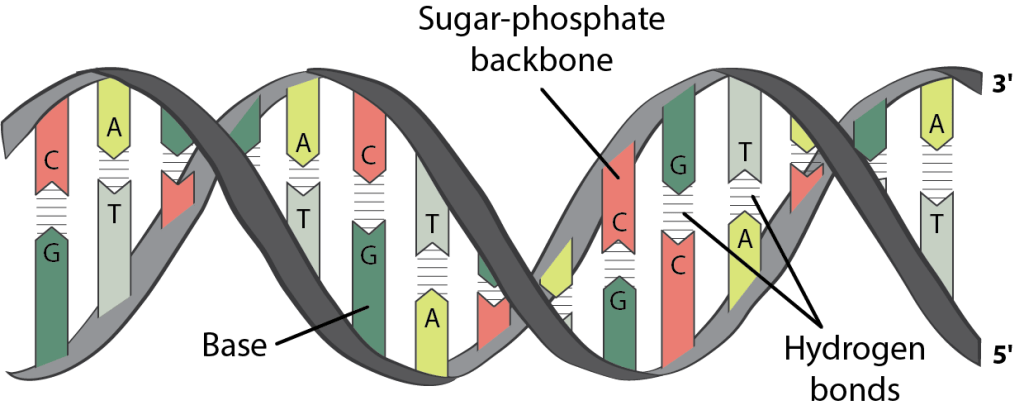Biological Macromolecules (TM)
Biological Macromolecules
There are four basic biological macromolecules that are common between all organisms: carbohydrates, lipids, nucleic acids, and proteins. These molecules make life possible by performing basic cellular functions.
Macromolecules are polymers, which are large molecules comprised of smaller molecules called monomers. The monomers are joined together in an endothermic (energy requiring) dehydration reaction, so-called because it releases a molecule of water. Conversely, the bonds in polymers can be broken by an exothermic (energy-releasing) reaction that requires water.
Carbohydrates
Carbohydrates, commonly known as sugars, are made up of carbon, hydrogen, and oxygen. The monomers of carbohydrates, called monosaccharides, have these elements in the ratio CnH2nOn. Common monosaccharides include glucose and fructose.
Monosaccharides bond together to build larger carbohydrate molecules. Two monosaccharides bond together to form disaccharides such as sucrose and lactose. oligosaccharides are formed when small numbers of monosaccharides (usually between two and ten) bond together, and polysaccharides can include hundreds or even thousands of monosaccharides.

Carbohydrates are often taken into the body through ingestion of food and serve a number of purposes, acting as:
- fuel sources (glycogen, amylose)
- means of communication between cells (glycoproteins)
- cell structure support (cellulose, chitin)
Carbohydrates are broken down to their constituent parts for fuel and other biological functions. Inability to process sugars can lead to health issues; for example, inability to break down lactose (often due to problems with the enzyme lactase, which serves this function) leads to lactose intolerance, and problems with insulin not working properly in the breakdown of sugars can lead to diabetes.
Lipids
Lipids, commonly known as fats, are composed mainly of hydrogen and carbon. They serve a number of functions depending on their particular structure: they make up the outer structure of cells, and can act as fuel, as steroids, and as hormones. Lipids are hydrophobic, meaning they repel water.
Cholesterol is one example of a lipid, and is essential for normal functioning, although excessive accumulation can cause inflammation issues and high blood pressure. There are two types of cholesterol: high-density lipoprotein (HDL) and low-density lipoprotein (LDL), with HDL commonly referred to as “good” cholesterol and LDL as “bad” cholesterol, as high levels of LDL in particular can cause health problems.
Proteins
Proteins serve an incredibly wide variety of purposes within the body. As enzymes, they play key roles in important processes like DNA replication, cellular division, and cellular metabolism. Structural proteins provide rigidity to cartilage, hair, nails, and the cytoskeletons (the network of molecules that holds the parts of a cell in place). They are also involved in communication between cells and in the transportation of molecules.
Proteins are composed of individual amino acids, each of which has an amino group and carboxylic acid group, along with other side groups. Amino acids are joined together by peptide bonds to form polypeptides. There are twenty amino acids, and the order of the amino acids in the polypeptide determines the shape and function of the molecule.
Nucleic Acids
Nucleic acids store hereditary information and are composed of monomers called nucleotides. Each nucleotide includes a sugar, a phosphate group, and a nitrogenous base.

There are two types of nucleic acids. Deoxyribonucleic acid (DNA) contains the genetic instructions to produce proteins. It is composed of two strings of nucleotides wound into a double helix shape. The backbone of the helix is made from the nucleotide’s sugar (deoxyribose) and phosphate groups. The “rungs” of the ladder are made from one of four nitrogenous bases: adenine, thymine, cytosine, and guanine. These bases bond together in specific pairs: adenine with thymine and cytosine with guanine.

Ribonucleic acid (RNA) transcribes information from DNA and plays several vital roles in the replication of DNA and the manufacturing of proteins. RNA nucleotides contain a sugar (ribose), a phosphate group, and one of four nitrogenous bases: adenine, uracil, cytosine, and guanine. It is usually found as a single stranded molecule.
There are three main differences between DNA and RNA:
- DNA contains the nucleotide thymine; RNA contains the nucleotide uracil.
- DNA is double stranded; RNA is single stranded.
- DNA is made from the sugar deoxyribose; RNA is made from the sugar ribose.
The Structure and Role of DNA
DNA stores information by coding for proteins using blocks of three nucleotides called codons. Each codon codes for a specific amino acid; together, all the codons needed to make a specific protein are called a gene. In addition to codons for specific amino acids, there are also codons that signal “start” and “stop.”
The production of a protein starts with transcription. During transcription, the two sides of the DNA helix unwind and a complementary strand of messenger RNA (mRNA) is manufactured using the DNA as a template.
This mRNA then travels outside the nucleus where it is “read” by a ribosome during translation. Each codon on the mRNA is matched to an anti-codon on a strand of tRNA, which carries a specific amino acid. The amino acids bond as they are lined up next to each other, forming a polypeptide.
A mutation causes a change in the sequence of nucleotides within DNA. For example, the codon GAC codes for the amino acid aspartic acid. However, if the cytosine is swapped for an adenine, the codon now reads GAA, which corresponds to the amino acid glutamic acid.
How might a mutation in a single codon affect the finished protein?
When it is not being transcribed, DNA is tightly wound around proteins called histones to create nucleosomes, which are in turn packaged into chromatin. The structure of chromatin allows large amounts of DNA to be stored in a very small space and helps regulate transcription by controlling access to specific sections of DNA. Tightly folding the DNA also helps prevent damage to the genetic code. Chromatin is further bundled into packages of DNA called chromosomes. During cell division, DNA is replicated to create two identical copies of each chromosome called chromatids.

